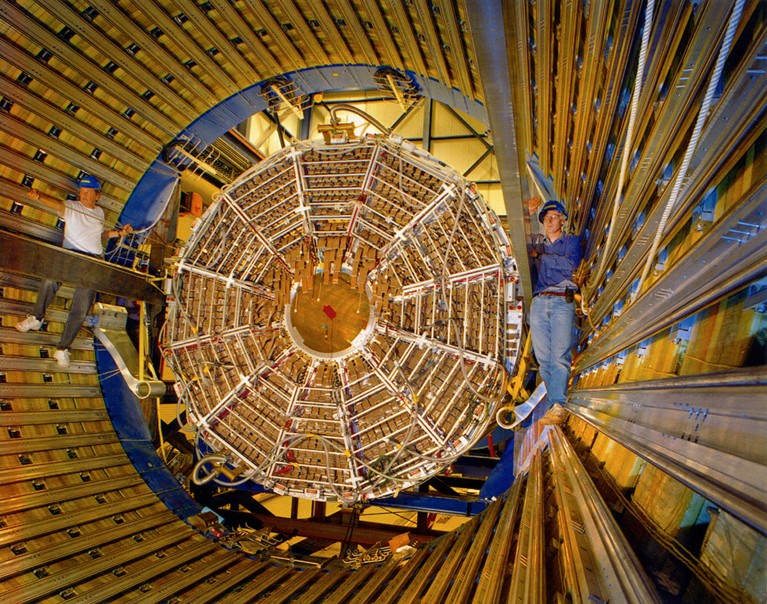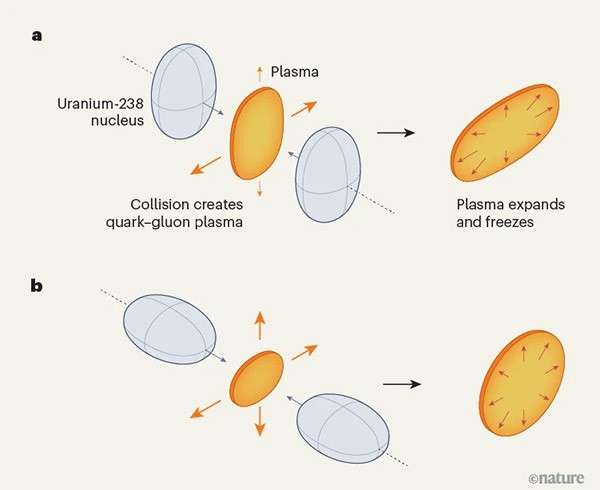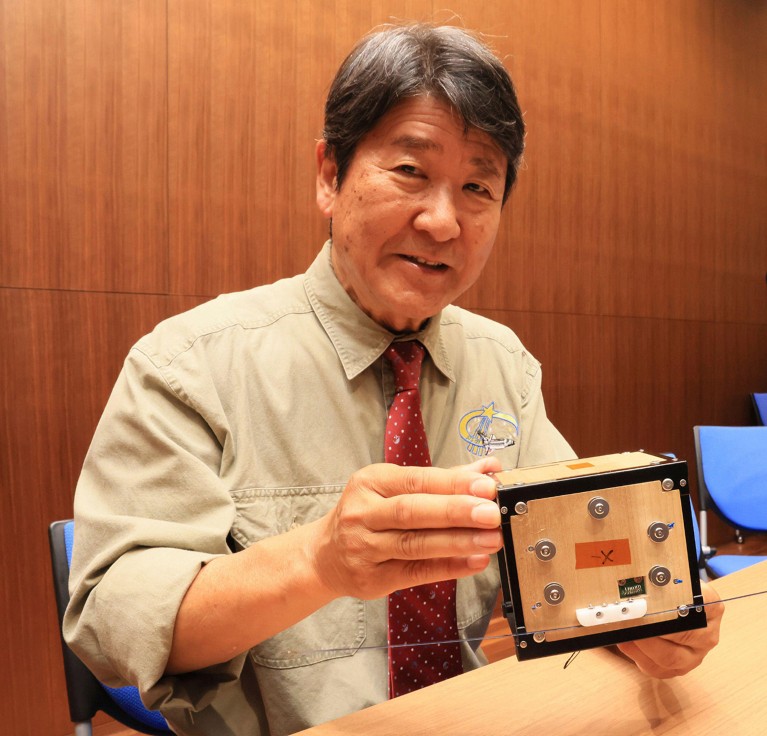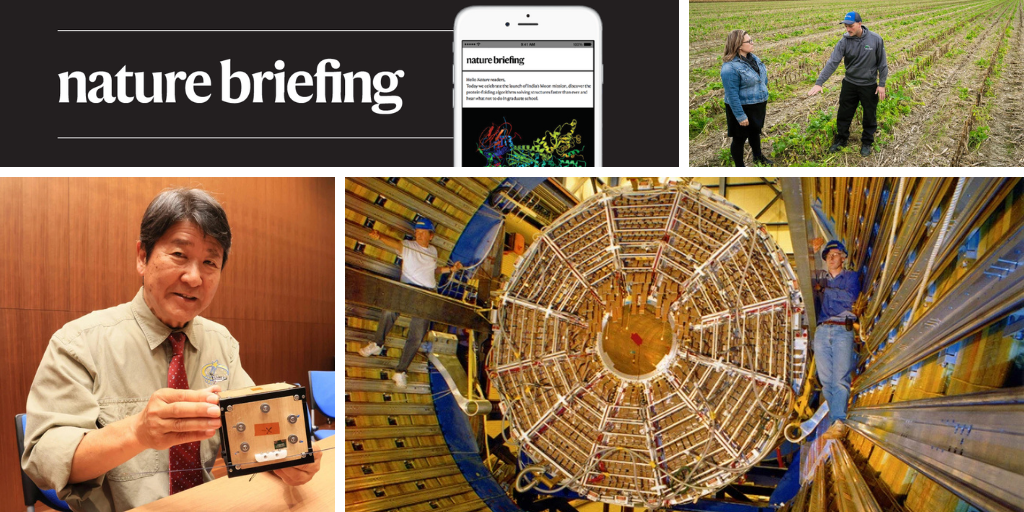Hello Nature readers, would you like to get this Briefing in your inbox free every day? Sign up here.

Inside the Relativistic Heavy Ion Collider’s STAR detector, which can track the thousands of particles produced when ions collide.Credit: Science History Images/Alamy
A new imaging method takes snapshots of atomic nuclei smashing together in high-energy collisions to help physicists better understand their shapes. Nuclei can take on a variety of forms, which can be tricky to predict: some are rigid and some fluctuate between several. The new method tracks the momentum of thousands of particles that result from collisions and matches the results with models to “roll back the clock to infer the shape of the nuclei”, says physicist Jiangyong Jia.

Colliding two beams of uranium-238 nuclei at extremely high energies destroys the nuclei and generates a state of matter called quark-gluon plasma. This plasma then expands and freezes into thousands of particles, the momentum of which can be tracked. Different patterns of momentum were produced depending on whether the nuclei collided side on (a) or head on (b), which allowed researchers to confirm the nuclei was kiwi fruit-shaped. (Nature News & Views | 6 min read, Nature paywall)
Researchers and environmental advocates want governments to offer financial incentives to farmers who use ‘regenerative’ practices to climate-proof farmland. They say that by improving soil health, crops can be made more resilient to drought and extreme weather. Practices such as rotating crops between fields can boost the diversity of microbes in the soil, helping it to retain nutrients and absorb water. Farmers who spoke to Nature say that regenerative agriculture does work, but it can take a few years of implementing it before farms start to see a profit.
A key molecular pathway promotes the sensation of pain caused by endometriosis and exacerbates the disease. Researchers blocked a protein called CGRP, which aids communication between the nervous system and immune cells, in mice with a condition like endometriosis using four medications approved by the US Food and Drug Administration for treating migraines. These drugs lessened the pain of the disease and two of them reduced lesion size. The study’s findings suggest that CGRP blockers might also be useful to treat endometriosis, an understudied condition with few available treatments, in humans.
Reference: Science Translational Medicine paper
The world’s first satellite made of wood, called LignoSat, was launched into space on Tuesday. A SpaceX mission carried the small, box-shaped satellite to the International Space Station, where it’ll later be released into orbit for six months. Designed by Japanese researchers, LignoSat was constructed using no screws or glue. Its electronic components will measure how wood fares in the extreme environment of space during its orbit. “With timber, a material we can produce by ourselves, we will be able to build houses, live and work in space forever,” said astronaut Takao Doi.

Takao Doi, an astronaut and engineer at Kyoto University, holds the world’s first wooden satellite.Credit: Kota Kawasaki/Yomiuri Shimbun via AP/Alamy
Features & opinion
Commercial antibodies don’t always work as they should — they often fail to recognize a specific protein or bind non-selectively to several targets. Even when working antibodies are out there, they can be hard to find. Neuroscientist Carl Laflamme co-founded an initiative that aims to characterize commercially available research antibodies for every human protein. But antibody vendors, funding agencies and scientific publishers are all getting in on the action to make antibodies that perform better and are easier to find for the researchers that need them.
Artificial intelligence (AI) tools can aid the process of peer review, but must be used responsibly, and with thoughtfully implemented guidelines, to maintain the integrity of the process, writes data scientist James Zou. “Outputs should be viewed as a starting point, not as the final answer,” he says. To ensure that AI does not dominate peer review, he suggests fostering more human interaction during the process using platforms such as OpenReview, which allows reviewers to discuss their questions anonymously.
Last month, I told you about the new largest-known prime number: 2136279841–1. The number was found by programmer Luke Durant, a volunteer participant in a project called the Great Internet Mersenne Prime Search, which calculates primes of the form 2n–1 defined by monk Marin Mersenne more than 350 years ago. Durant, who calculated the number using only publicly available unused cloud computing power, says that it took a year of work and about US$2 million of his own money to get there. “I was able to find this number that’s astonishingly large … but I was able to do it just by using big tech’s leftovers,” he says. “So it’s trying to [highlight the fact that] we have these incredible systems, so let’s figure out how to best use them.”
Today I’m marvelling at the newly discovered Brachycephalus dacnis, a species of flea toad less than 7 mm in length. The tiny toad went through ‘miniaturization’ during its evolution, say the biologists that discovered it, meaning it ditched a few parts of its larger ancestors’ anatomy in the process of shrinking down.
Let us know if there’s anything we should lose from — or add to — this newsletter at [email protected].
Thanks for reading,
Jacob Smith, associate editor, Nature Briefing
With contributions by Flora Graham
Want more? Sign up to our other free Nature Briefing newsletters:
• Nature Briefing: Careers — insights, advice and award-winning journalism to help you optimize your working life
• Nature Briefing: Microbiology — the most abundant living entities on our planet — microorganisms — and the role they play in health, the environment and food systems
• Nature Briefing: Anthropocene — climate change, biodiversity, sustainability and geoengineering
• Nature Briefing: AI & Robotics — 100% written by humans, of course
• Nature Briefing: Cancer — a weekly newsletter written with cancer researchers in mind
• Nature Briefing: Translational Research — covers biotechnology, drug discovery and pharma


